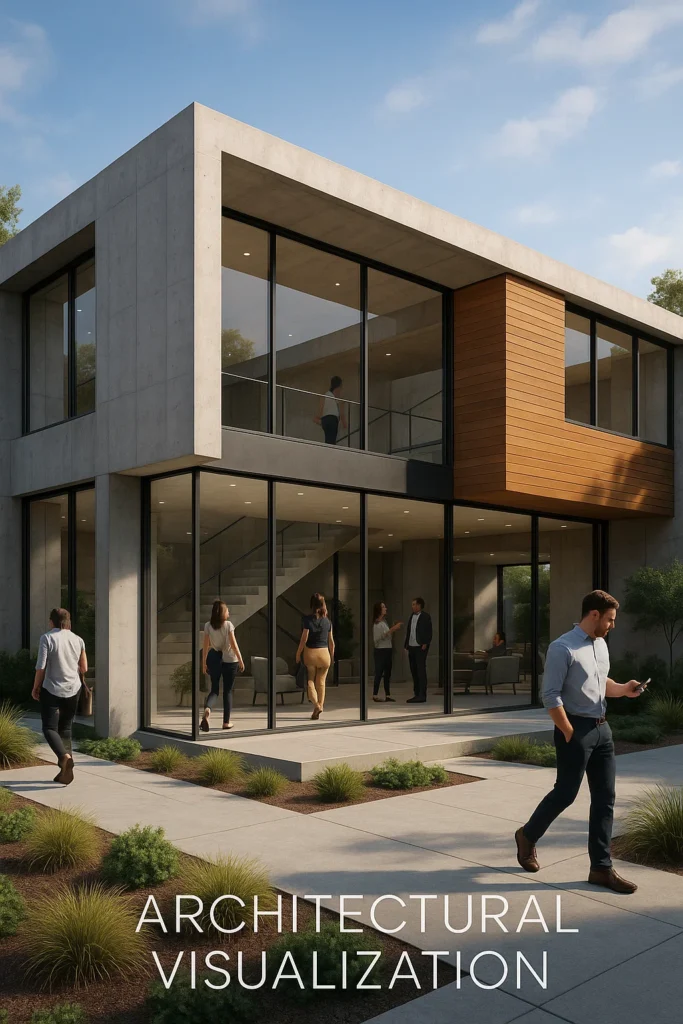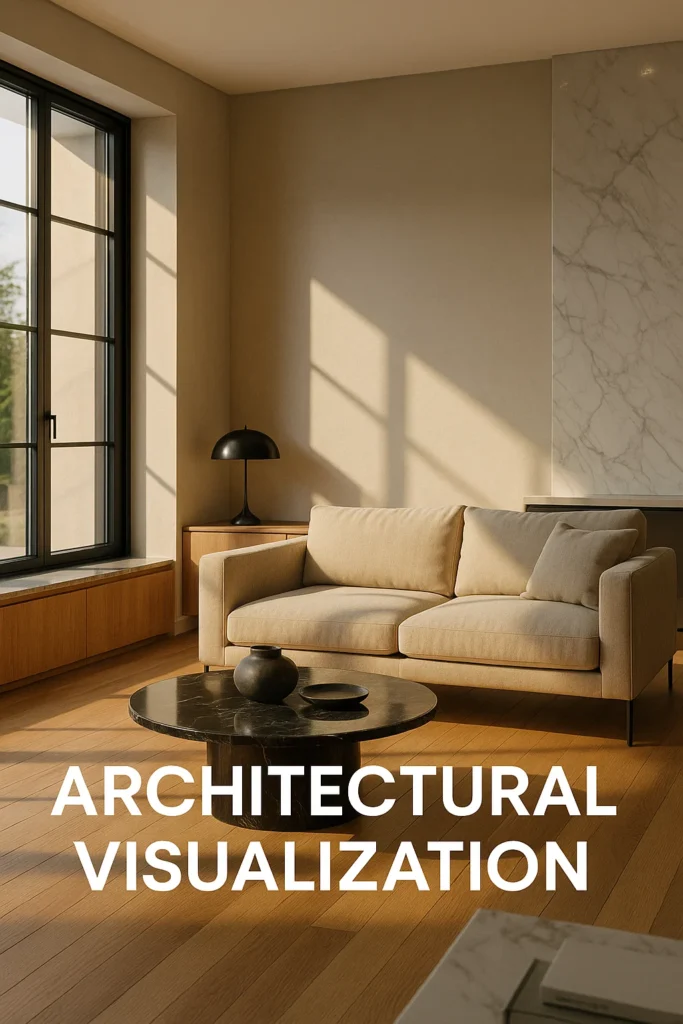In today’s aggressive architectural, real property, and design industries, 3D architectural visualization offerings have become a sport-changer. No longer simply an add-on, these services at the moment are integral to the layout process, improving verbal exchange, rushing up approvals, and supporting stakeholders see the destiny earlier than an unmarried brick is laid. Tricon 3D one of the best companies who provide all the facilities of architectural visualization
Whether you’re an architect, interior dressmaker, actual estate developer, or marketing organization, architectural visualization can raise your undertaking from concept to truth with precision and style.

Here are the top 10 blessings of the usage of architectural visualization services
1) Brings Design Concepts to Life:
One of the most significant advantages of 3D visualization is its ability to turn flat drawings into lifelike models. Clients and investors no longer need to rely on their imagination, photorealistic visuals present the project exactly as it will appear upon completion.
Architectural visualization has the ability to convert abstract ideas into visible, visible realities. In traditional architecture, customers are often expected to explain 2D-floor arrangements, height and technical paintings-it can be difficult to understand it completely, while accurate, non-professional. This communication difference often leads to misunderstanding, hesitant or abandoned outdated opportunities.
From Blue Blueprint to real view:
The 3D architectonic visualization sketch, AutoCAD drawing or BIM models are reducing this difference by converting the BIM model into a realistic digital representation. These visual materials, lighting, furniture, texture and even natural surroundings – customers will see and feel what they want to see and feel before the same nail hammer.
For example, a residential customer can see his future kitchen fittings with natural morning lights, granite countertops and customized cabinets, all have been brought into life in a digital scene. Similarly, a real estate developer can demonstrate the entire housing development with people for landscape architecture, roads and eastern selling and investor paths.
2) Improves Client Communication:
Architectural terms and 2D plans can confuse non-technical stakeholders. A 3D rendering bridge that makes it easy to explain holes, design options and imagine layout, light, materials and location. This leads to smooth communication and quick approval.
One of the most impactful benefits of architectural visualization is its capability to dramatically enhance verbal exchange among professionals and clients. Architecture and design are inherently visual disciplines, but they frequently rely upon technical documents—like blueprints, ground plans, or CAD drawings, that many clients discover tough to interpret.
3D architectural visualization bridges the distance among technical precision and visible clarity, allowing architects, designers, and developers to talk ideas in a shape that clients right away understand.
Why Traditional Methods Often Fail:
When clients are provided with 2D plans or line drawings, they ought to mentally visualize how those strains and logos translate right into a bodily space. This turns into even more tough when discussing summary elements along with scale, mild, material texture, or the spatial float between rooms. Misunderstandings at this stage can result in:
Confusing conferences
Delayed selections
Costly layout revisions later inside the procedure
How Architectural Visualization Changes the Conversation:
With three-D renderings, animations, or even digital fact tours, professionals can now present photorealistic or stylized fashions of the proposed space—fully provided, lit, landscaped, and often animated with humans or natural results. This gives clients a clear, immersive understanding of the design long before creation starts.
It also allows you to:
Compare design alternatives facet-by using-facet (e.G., material finishes, shade palettes, fixtures layouts)
Present distinctive lighting conditions (day/night, seasonal)
Walk through the gap certainly, allowing more unique remarks
3) Increases marketing and sales:
High quality 3D views are powerful marketing tools. From property brochures and websites to investors presentations and social media campaigns, architectural visualization helps buyers and investors to attract assets by performing assets in the best possible light – before they are not produced.
Professional marketing material:
The architectural visualization offers a wide range of visual assets that can be used in many marketing platforms:
Website galleries
Social media campaign (Instagram, LinkedIn, Pinterest)
Property listing and portals
Print brochure and sales catalog
Investor Pitch Deck
Real -time virtual trip or 3D review video
These high quality scenes give your project a Polish, professional edge-you stand out by the participants and create a permanent impression on the possibilities.
4) Fast project approval
Getting approval from customers, making plans authorities, buyers, or regulatory boards is regularly one of the maximum time-consuming levels in any architectural or construction undertaking. Delays can cost time, money, and momentum. One of the maximum treasured roles of architectural visualization is its potential to accelerate the approval manner through making designs clearer, greater persuasive, and less difficult to understand for all stakeholders.
Overcoming Communication Barriers:
Traditional assignment proposals rely closely on technical drawings, written specifications, and complicated terminology. While experts in the enterprise can interpret these without problems, clients, investors, and public officials regularly struggle to fully hold close what the finished assignment will seem like. This leads to:
Endless clarification meetings
Design revisions because of misunderstanding
Delayed or denied lets in and investment decisions
Architectural visualization solves this hassle via providing a clean, visible narrative. Through remarkable 3-D renderings or animations, each stakeholder can understand the layout in seconds, regardless of their history.
Making Approvals More Visual and Interactive
Using equipment like:
Three-D renderings (interior and outdoors)
Virtual walkthroughs
360-diploma panoramas
Animated flythroughs or drone-fashion digicam moves task teams can gift their vision in approaches that feel real and immersive. Instead of asking a town planner to approve a zoning change primarily based on ground plans, you’re displaying them how the task will appearance inside the community, the way it interacts with the surroundings, and the way it enhances public space.
5) Quickly recognize design errors
With 3D visualization, it is easy to present potential design problems before construction starts. From structural deviations to aesthetic imbalance, it is easier to change digitally than site savings, wealth and materials.
Even the most experienced architects and designer can ignore small – but expensive – in the order phase. Fortunately, the 3D architectonic visualization helps you and your team catching these problems quickly by providing a clear, detailed and accurate picture of the project before construction starts.
This active approach can prevent the deficiencies in the design, reduce work again and eventually save time, money and reputation.
Why 2D images are not always enough:
Traditional 2D blue and floor plan shows dimensions, setup and composition, but they do not always state how elements interact in the real world. It can give rise to hidden problems, for example:
Strangely spatial arrangement
Incorrect structural item
Bad natural lighting
Collision material or color selection
Limited access or circulation problems
Because 2D plans require interpretation, even skilled professionals cannot present the design errors until later in the construction process – when fasting is expensive and disruptive.
6) Supports Virtual Walkthroughs and Tours
Thanks to 3D animation and VR integration, customers can now go through “almost” rooms. This engrossing experience provides deep understanding of spatial mobility, flow and functionality-special useful in high final housing or commercial development.
One of the most dynamic and engrossing applications of architectural visualization is a virtual review – a device that allows customers, investors and stakeholders to experience a project as if they were physically in it even before they started construction.
Unlike stable images or drawings, virtual trips provide a 360-degree room, in real-time discovery. They increase understanding, encourage commitment and help customers to be emotionally linked to the project.
What is a virtual review?
A virtual review is a digitally presented simulation that allows the audience to “go” through a 3D model of a building, room or development. Depending on technology, these may vary from pre-varied animation to a fully interactive, user control experiences that act as a video game or VR environment.
Review usually shows:
Room-for-room navigation
Realistic light and shadow
Saj decoration, texture and finish
External views and surroundings
Natural flow
These properties provide an intuitive feeling of a gut, scale, proportion and environment, which is often difficult to express through images or still rendering.
Why are they so powerful:
Customers, especially not familiar with architectural images, can imagine a difficult time how a place will really feel. A virtual review allows them:
Understand how rooms connect and float
Imagine functionality and furniture setup
Identify what they like – and don’t like until the building starts
Talk to the environment, especially in VR-based experiences
This leads to more informed decision -making, the low design replaces the road and high customer confidence.
7) Saves time and cost
It is expensive to correct errors in the construction phase. With 3D reproduction, these problems can be solved under the plan. Clear images also reduce the number of modification cycles, making the whole process more efficient.
In architecture, design and construction industries, time is money – and errors or delays in communication, planning or execution can lead to significant cost overrun. Architectural visualization plays an important role in streamlining work flakes, reducing errors and accelerating the decision, which directly helps to save both time and costs in the life cycle of a project.
Quick decision:
Customers often require time to decide on material, layout or design options – especially when they do not quite understand technical images or conflict to imagine space. 3D reproduction and high -quality review speeds up this process so that they can let the design look and understand immediately.
When customers can imagine the end result:
They approve quickly
They beg for low revision
They feel more confident about the choice
This small project between stakeholders leads to the deadline and less back and forth.
8)Provides Better Cooperation
Successful architectural initiatives require seamless collaboration among a huge variety of stakeholders: architects, indoors designers, engineers, contractors, builders, city planners, and clients. Without clear communication and mutual know-how, even well-designed tasks can be afflicted by misalignment, delays, or highly-priced errors.
Architectural visualization complements cooperation with the aid of growing a shared, visual language that every one events can apprehend and work from—regardless of their technical historical past.
Breaking Down Silos:
In conventional workflows, different team contributors regularly function in silos:
Architects consciousness on spatial layout
Engineers give attention to structural feasibility
Contractors study buildability
Clients are concerned with aesthetics, feature, and value
With 2D plans or technical documents on my own, these corporations may additionally interpret the design in another way or pass over important information. But a 3-D architectural visualization brings every body onto the equal web page—literally and figuratively.
When all stakeholders can see the same design really, it minimizes miscommunication and lets in for higher collaboration from the very beginning.
9) Provides material and light accuracy
Modern visualization tools can simulate how materials and lights will behave under real conditions. This helps customers eliminate more confident and coordinate the end result with expectations.

10) Provides competitive advantage
In a crowded market, high quality 3D visualization offers to separate your brand. It adds professionalism, builds trust and increases the chances of securing projects or investments – definitely use in industries where visual impact matters.